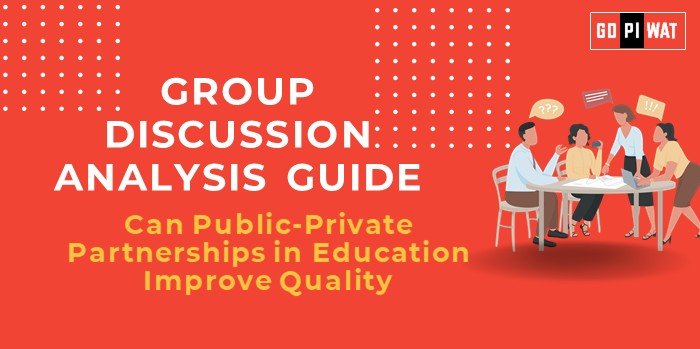📋 Can Public-Private Partnerships in Education Improve Quality?
🌐 Group Discussion (GD) Analysis Guide
💡 Introduction to the Topic
Context Setting: Public-private partnerships (PPPs) in education aim to combine government oversight and private sector efficiency to address challenges of quality and access. For B-school aspirants, this topic connects with strategic management, policy frameworks, and societal development.
Background: With a global focus on inclusive and quality education, PPPs offer a hybrid model that leverages private investment and innovation while ensuring public accountability. Notable examples include the UK Academies Program and India’s Sarva Shiksha Abhiyan PPP initiatives.
📊 Quick Facts and Key Statistics
- 💰 India’s Education Budget (2023-24): ₹1.12 lakh crore allocated for school education.
- 🌍 Global Spending on Education (UNESCO): Public expenditure ranges from 4-6% of GDP in developed nations; PPPs help bridge gaps in developing economies.
- 📈 PPP Schools in India: Report 20% higher attendance rates compared to public schools.
- 🚀 Education Sector Growth: Expected CAGR of 8.1% (2022-2028), driven by technology integration.
🤝 Stakeholders and Their Roles
- 🏛️ Government: Creates policies, monitors quality, and provides funding subsidies.
- 🏢 Private Sector: Invests in infrastructure, innovates curriculum, and integrates technology.
- 🤝 NGOs: Support implementation, advocacy, and teacher training programs.
- 🌍 International Organizations: Entities like the World Bank and UNICEF provide funding and frameworks for PPPs.
- 👨👩👧 Students and Parents: Demand accountability and actively participate in feedback mechanisms.
🏆 Achievements and ⚠️ Challenges
✨ Achievements:
- 🏫 Improved Infrastructure: PPP schools provide better facilities than traditional public schools (e.g., Delhi’s PPP schools).
- 📈 Enhanced Learning Outcomes: Students in PPP-supported institutions show 15% higher test scores.
- 💻 Technological Integration: Digital platforms like BYJU’S and other Ed-Tech solutions enhance personalized learning in PPP schools.
⚠️ Challenges:
- ⚖️ Equity Issues: Accessibility and affordability remain barriers for disadvantaged groups.
- 📜 Accountability Concerns: Balancing profit motives with public welfare goals is challenging.
- 🌐 Global Comparisons: In Chile, a voucher system under PPPs delivered mixed results, raising concerns about equity and inclusivity.
Case Study:
🌟 Rajasthan’s PPP Model: Focused on secondary education, this initiative improved pass rates by 25% and enhanced school facilities across underserved areas.
🗣️ Structured Arguments for Discussion
- Supporting Stance: “PPPs enhance resource efficiency, bringing innovation and accountability to education.”
- Opposing Stance: “Privatization through PPPs risks sidelining equity and access, deepening educational disparities.”
- Balanced Perspective: “While PPPs offer substantial benefits, strong regulatory frameworks are essential to mitigate risks and ensure inclusivity.”
💬 Effective Discussion Approaches
🔹 Opening Approaches:
- 📊 Equity Highlight: “Public education often struggles with equity issues. PPPs offer an opportunity to bridge resource gaps effectively.”
- 🌟 Case Study: “Rajasthan’s PPP model improved pass rates by 25%, demonstrating the impact of collaborative initiatives.”
- 📈 Statistical Impact: “PPP schools in India have shown 20% higher attendance rates and better infrastructure than public counterparts.”
🔄 Counter-Argument Handling:
- ⚖️ Address equity concerns by proposing solutions like subsidized access for underprivileged students.
- 🛡️ Emphasize the need for regulatory frameworks to ensure transparency, accountability, and quality delivery.
📊 Strategic Analysis of Strengths and Weaknesses
- 💪 Strengths:
- 🌍 Optimized resource allocation and improved infrastructure.
- 📚 Introduction of skill-based training and technology-enhanced learning.
- 🔻 Weaknesses:
- ⚠️ Risk of profit-driven motives overshadowing educational quality.
- 🏫 Dependence on external entities may limit long-term sustainability.
- 🚀 Opportunities:
- 🌱 Expansion in rural and underserved regions.
- 💻 Collaboration with Ed-Tech firms for broader outreach.
- ⚠️ Threats:
- 🛑 Regulatory and policy challenges.
- 🌐 Unequal access exacerbating societal divides.
📚 Connecting with B-School Applications
Real-World Applications:
- 💼 Case Studies: Analyze PPP-driven education reforms and blended finance models.
- 📊 Strategic Management: Evaluate feasibility, risk mitigation, and scalability metrics in PPP projects.
🔍 Sample Interview Questions:
- 💬 “How do PPPs address the resource gap in education systems?”
- 🌍 “Can PPPs sustain quality education in underserved regions without compromising equity?”
💡 Insights for Students:
- 📊 Develop project feasibility analysis and risk-mitigation strategies.
- 🌟 Explore scalable models of PPPs that balance innovation with public accountability.


